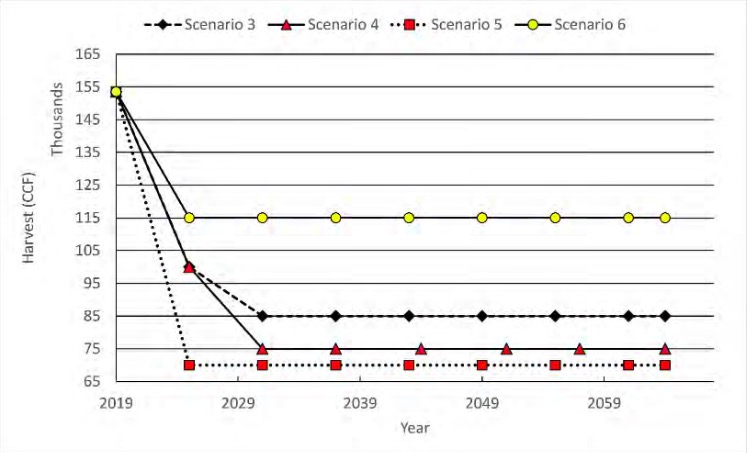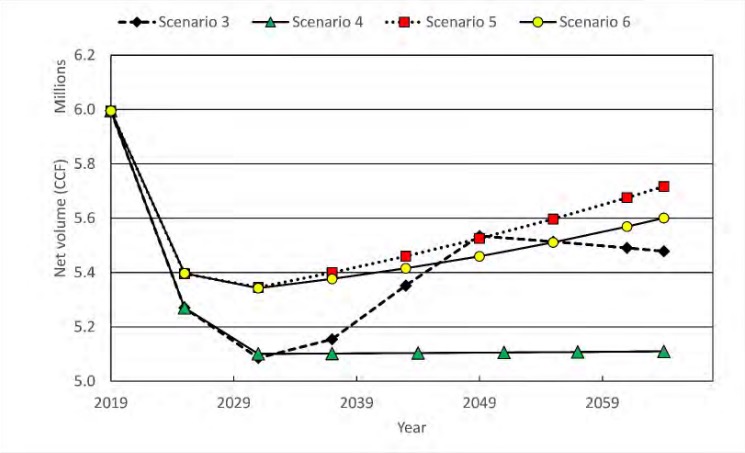Want a job with social distancing? Join the National Forest Service. Just imagine tromping around the Black Hills all alone all day long, measuring trees, watching for mountain lion and bear scat….
Our estimable silviculturists have been out in the Black Hills counting Pinus ponderosa and trying to get a mathematical handle on how many of those stately pines we can chop down and turn into cabins and sheds and shelves and such. (By the way, the coronavirus recession has sent the lumber commodity price down over 40% since its February 20 peak.) In a draft technical report posted March 5 and discussed at a three-hour public teleconference Friday, the Forest Service scientists conclude that we are chopping down twice as many trees as current Black Hills timber stock at current growth and mortality rates can support and that if we keep harvesting timber at current rates, we’ll deplete the Black Hills of all sawtimber by 2054.
Now that “twice as many” is rough, as growth and mortality depend on all sorts of variables that we’ve seen change (and which we have changed via carbon emissions) over the past decades. But the draft report says that in 2019, we harvested 153,534 CCF (the first C is a Roman 100; the unit is thus “hundred cubic feet,” which processes down to maybe 630 board feet of lumber, or not quite 80 eight-foot 2×6 boards, maybe a third of what you need for exterior studs on a 1,200-square foot house) from the 765,733 acres of the Black Hills suitable for logging. The current forest plan allows an annual harvest of up to 181,000 CCF of sawtimber. Mountain pine beetle and wildfire have increased since that level was set in 2005. The standing live inventory of ponderosa pine dropped 13% from 2017 to 2019, from 6.893 million CCF to 5.995 million in 2019. Sustaining annual harvests of 181,000 CCF would require getting the standing inventory of ponderosa pine back up to twelve million CCF.
I’m a math major, not a silviculturist, but by my spreadsheet, doubling the ponderosa pine count would require banning logging in the Black Hills unitl 2068.
Given the unlikelihood of that plan, we can settle for sustaining the current ponderosa pine inventory. The draft report offers different scenarios for different harvest timeframes and assumptions about growth and mortality, but basically, we could keep the forest inventory about where it is by scaling back timber harvest in the Black Hills over the next ten years to 70,000 CCF or maybe, under really hopeful mortality assumptions, 115,000 CCF.


Seth Tupper notes in his report on the public teleconference that the Black Hills produces more lumber than any other national forest. Conservationists at the meeting expressed the obvious conclusion that maybe we’re overdoing it and need to let the forest breathe. Big Wood, naturally, said otherwise:
“Forest products companies are not the enemy,” Danley said. “We are a major tool that the Black Hills National Forest has in maintaining a healthy forest for over hundreds of years.”
Timber-industry speakers also disagreed with the Forest Service’s research findings about tree numbers. And they said reducing the timber harvest could drive timber companies away, along with some of the 1,400 jobs in the Black Hills timber industry [Seth Tupper, “Research Kicks off Debate on Future of Black Hills Logging,” SDPB, 2020.04.04].
If the industry can offer some reliable counterfigures showing the Forest Service undercounted good trees, then sure, keep on chopping. But as we see from coronavirus, we can’t just shout “But jobs!” as an excuse not to take action against a clear threat to health, whether public health or forest health. If bars keep serving drinks at normal rates right now, they’ll run out of drinkers (or at least cause two million deaths and a catastrophic collapse of the health care system). If loggers keep logging the Black Hills at current rates, according to the science presented, they’ll run out of logs in 34 years. Sometimes to stay in business, you have to do less business.
But hey, loggers—we could always use more silvculturists….
Sounds like what man is doing world wide to quickly grab that almighty greenback. Just read an article a short while ago about a Brazilian rain forest anti logging activist that was murdered. Capitalism run a muck.
There are places in the Black Hills along Highway 385 where ALL of the big trees have been harvested leaving only short trees which will not mature to minimum cutting size for at least 50 years. As I understand it logging rules were suspended during the recent pine beetle epidemic. Those rules would have required environmental impact statements on timber sales. Those rules are still suspended.
I think Ray points to what I feared most. The bugs were used as an excuse to ignore good forest management and flout environmental laws. This was all encouraged by the pea-brained politicians like Thune and Rounds, all for campaign donations. Ray points to the cutting of the big trees, which is the age cohort that should have been preserved for good forest management. Cut the small trees and selectively cut the medium sized trees, and you get back some of the natural forest properties.
The cut is far, far above what it should be, and they are cutting the wrong trees.
They’re looking on the wrong side of the state. Lots of beautiful ash trees have been cut down in Sioux Falls, and the cutting seems to be still going on. I recall an estimate of 80,000 ash trees that had to go.
We need to offset Trump, Putin and Noem’s climate ignorance.
Mr. Pay, good rant about EB5 Rounds and Moscow Thune, but please, don’t forget the dust bunny GNOem on this. In fact, she even had her donors come to Washington (how the hell did that get paid for) to testify. Methinks she is the culprit here, but that’s just me.
“WASHINGTON — Twice in the last four months, Republican Rep. Kristi Noem has held or testified at congressional hearings in South Dakota and Washington where the tables were packed with witnesses who between themselves, their employees and their families have given her a total of more than $19,000 in campaign contributions.
Noem is the lone U.S. House member from South Dakota, with $790,224 in her campaign account. The congressional hearings focused on farm dust regulation and pine beetles, both critical issues to her constituents.
In a July hearing for the House subcommittee on national parks, forests and public lands in Hill City, S.D., on a mountain pine beetle epidemic in the Black Hills, two of three non-government witnesses each gave $1,000 or more to her congressional campaign account. The other three witnesses worked for the U.S. Forest Service or the state agriculture department.” Rapid City Journal 10.31.2011
If you might remember, GNOem had one of the Lien’s testify…about farm dust??? what?
“Lien, the owner of Lien & Sons, Inc. a S.D.-based mining company, spoke on behalf of the National Stone, Sand and Gravel Association. In addition to his own donations Lien’s family and employees gave Noem’s campaign an additional $6,000 in donations.”
Guess they farm at those gravel pits by drilling wheat, who knew that? It’s a very good article from the Associated Press on just how blatant a con artist like GNOem actually is. Fits right into what we see from Don the Con.
Lien would be happy to blanket the West side of Rapid City and all of Black Hawk in daily dust clouds. Instead, they have to pay someone to drive a water truck around sprinkling water on the dirt and gravel paths Lien trucks take. It’s so unfair!! Such a burden!!